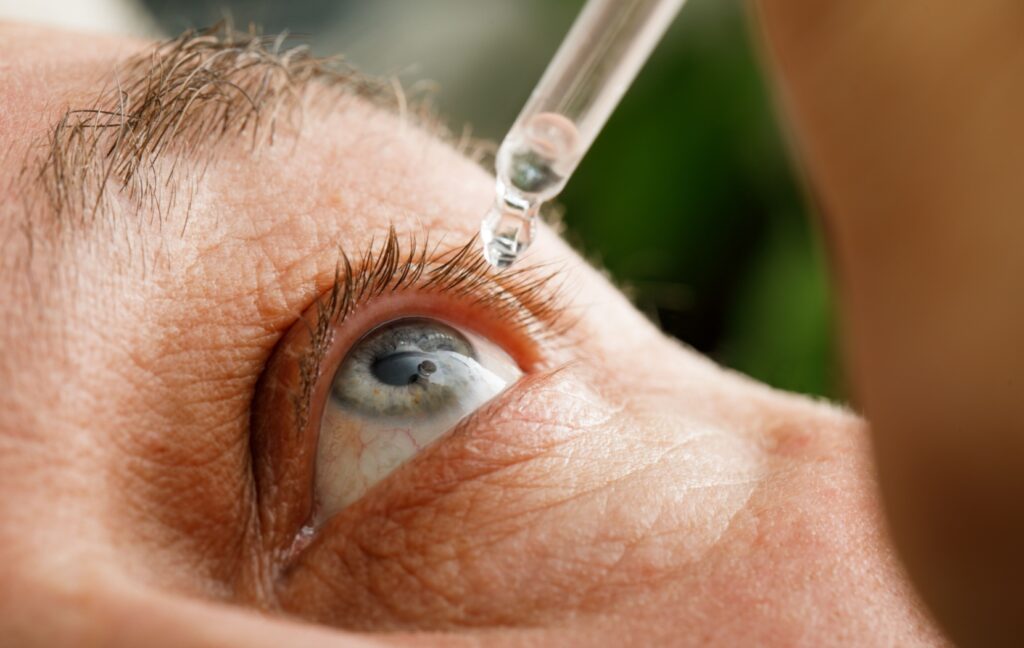Dry eyes can feel like more than just a minor inconvenience; they disrupt your work, leisure activities, and daily routines. One common symptom of dry eye that many people experience is blurry or fluctuating vision. While this vision disturbance is often temporary, severe dry eye can lead to changes in eye health that may impact your long-term vision.
The good news? If you’re experiencing dry eyes, blurry vision, or eye strain, your eye care provider can offer effective solutions. Understanding the connection between dry eyes and vision problems is the first step toward finding relief.
What Is Dry Eye Syndrome?
Dry eye syndrome develops when your eyes don’t produce enough tears or when the composition of your tears can’t properly lubricate your eyes. This condition affects millions of Canadians and can impact quality of life.
Your tears serve multiple purposes beyond keeping your eyes moist. They play a vital role in removing debris, fighting infection, and creating a smooth optical surface that supports clear vision. When this delicate system becomes disrupted, various symptoms can emerge.
Common symptoms of dry eye can include:
- Blurry vision
- Persistent dryness or grittiness
- Burning or stinging sensation
- Redness in the whites of the eyes
- Watery eyes caused by reflex tearing
- Light sensitivity
Among these symptoms, blurry vision can make everyday tasks, such as driving, reading, or working on a computer, particularly challenging and frustrating.
How Does Dry Eye Syndrome Cause Blurry Vision?
The relationship between dry eye and blurry vision is more complex than you might think. Your tears create the foundation for clear sight, so when this system fails, your vision suffers. Let’s explore the specific mechanisms behind this connection.
Disrupted Tear Film
Your tears consist of three distinct layers, oil, water, and mucus, that work together to form a stable tear film across your eye’s surface. This tear film creates a smooth surface that allows light to pass through, supporting clear and sharp vision.
When dry eye syndrome disrupts this tear film, it becomes uneven and unstable. Light scatters instead of focusing properly on your retina, leading to blurry or inconsistent vision that may fluctuate throughout the day.
Corneal Damage
Chronic dryness can cause micro-abrasions or damage to the cornea, the clear, dome-shaped surface at the front of your eye. These small injuries may seem minor, but they can distort how light enters your eye, ultimately interfering with your vision clarity.
Over time, repeated corneal damage can lead to more serious complications if left untreated, making early intervention crucial for protecting your long-term eye health.
Inflammation Response
Dry eye syndrome triggers inflammation that can irritate and swell the eye’s surface. This inflammatory response creates a cycle where dryness leads to inflammation, which then worsens dryness and vision problems.
As inflammation persists, it can cause blurry vision to become more frequent and severe, affecting your ability to perform daily activities comfortably.
Reflex Tearing
Paradoxically, dry eye sometimes causes excessive tearing as your body attempts to overcompensate for the dryness. However, these reflex tears lack the proper balance of nutrients and oils needed for adequate lubrication.
These poor-quality tears don’t contribute to clear or stable vision, often causing your eyes to feel watery while still experiencing dryness and blurred vision.
What Causes Dry Eye?
Understanding the root cause of your dry eye symptoms helps determine the most effective treatment approach. For many people, symptoms result from a combination of factors rather than a single cause.
Lifestyle Factors
Daily habits and environmental conditions significantly impact your eye health:
- Extended screen time reduces your blink rate, leaving your eyes inadequately moisturized
- Low-humidity environments, such as air-conditioned or windy spaces, accelerate tear evaporation
- Smoking or exposure to pollution irritates the eyes and disrupts tear film quality
Age-Related Changes
Tear production naturally decreases as you age, making dry eye syndrome more common among older adults. This biological change affects both the quantity and quality of tears your eyes produce.
Medical Conditions & Medications
Systemic conditions like diabetes, rheumatoid arthritis, and thyroid disorders are often linked to dry eye symptoms. Additionally, medications such as antihistamines, antidepressants, and diuretics can reduce tear production as a side effect.
Contact Lens Wear
Soft contact lenses absorb water to maintain flexibility, including moisture from the surface of your eyes. Long-term contact lens use can disrupt the natural tear film, contributing to chronic dryness and vision problems.
Treating Dry Eyes & Blurry Vision
Dry eye and related symptoms, such as blurry vision, are highly treatable with the right approach. A personalized treatment plan can significantly enhance your comfort and restore visual clarity.

Artificial Tears
Over-the-counter artificial tears provide quick relief by replenishing moisture in your eyes. Choose preservative-free versions if you use them frequently to avoid additional irritation.
Lifestyle Modifications
Simple changes to your daily routine can make a substantial difference:
- Take regular breaks during screen time to rest your eyes and encourage blinking
- Use a humidifier in your home or workplace to combat dry air
- Wear sunglasses outdoors to protect against wind and UV rays
- Stay hydrated and incorporate omega-3 fatty acids into your diet
Advanced Treatments
For severe cases, clinical treatments can address underlying causes. Meibomian gland expression helps unclog blocked glands, while modern therapies like intense-pulsed light (IPL) and radiofrequency treatments target tear glands to help improve production.
Taking Action for Your Eye Health
Occasional dryness after extended screen time isn’t always concerning. However, persistent symptoms warrant professional attention. Blurry vision can signal worsening inflammation or surface damage that may lead to serious complications if left untreated. At Village Optical, we understand how dry eye can impact your daily life. Our experienced team provides comprehensive evaluations and personalized treatment plans to address your specific needs. Give the Village Optical team a call at 431-813-2757 to speak with our ocular hygienist. We’ll help you schedule an appointment with one of our dry eye specialists to discover practical solutions for lasting relief.



